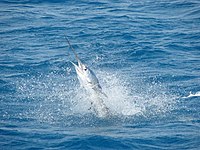
Photo from wikipedia
Giant clams (Tridacninae) are largely threatened globally, but information regarding their distribution and abundance is deficient in many locations, including in the Republic of Mauritius, situated in the Western Indian… Click to show full abstract
Giant clams (Tridacninae) are largely threatened globally, but information regarding their distribution and abundance is deficient in many locations, including in the Republic of Mauritius, situated in the Western Indian Ocean region. In this study, we investigated the spatio-temporal variation in the population density of giant clams in April and May 1999, 2010, and 2016 at seven reef sites around Mauritius: three marine protected areas (MPAs) and four non-MPAs, using three 250 m2 belt transects at each sites. Two species of giant clams were identified in the surveys as Tridacna maxima and Tridacna squamosa, and further classified into: juveniles (shell lengths, 0.1–79 mm for T. maxima and 0.1–149 mm for T. squamosa) and adults (shell lengths, ≥ 80 mm for T. maxima and ≥ 150 mm for T. squamosa). Our results showed a significant decline in the densities of both species from 1999 to 2016 at all seven sites. A weak positive relationship was observed between the adult and juvenile categories in T. maxima (r = 0.340, p = 0.602) and a strong positive relationship was observed between the adult and juvenile categories in T. squamosa (r = 0.887, p = 0.094) at the MPAs, but opposite relationships were found in non-MPAs. Findings suggest an overall significant decline in densities of tridacnines, for both species and size classes, irrespective of protection levels at sites. This study warrants further investigations to thoroughly understand the potential causes of tridacnine decline in order to better formulate conservation and management strategies for this unique, threatened marine bivalve in Mauritius.
Journal Title: Marine Biodiversity
Year Published: 2018
Link to full text (if available)
Share on Social Media: Sign Up to like & get
recommendations!